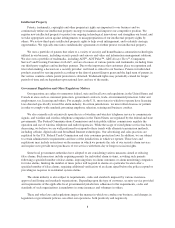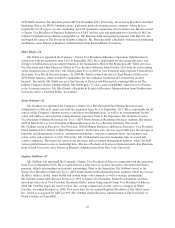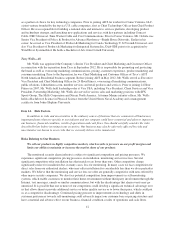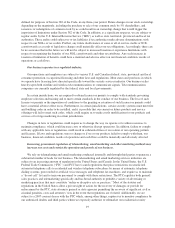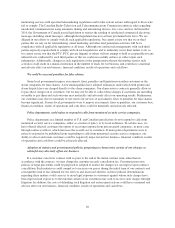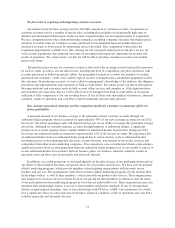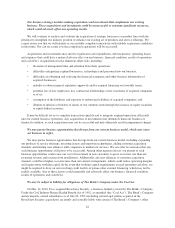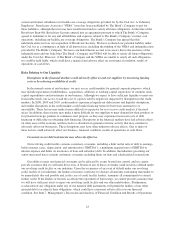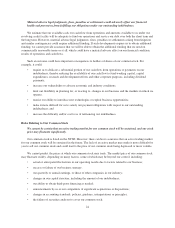ADT 2012 Annual Report Download - page 107
Download and view the complete annual report
Please find page 107 of the 2012 ADT annual report below. You can navigate through the pages in the report by either clicking on the pages listed below, or by using the keyword search tool below to find specific information within the annual report.Infringement of our intellectual property rights could negatively affect us.
We rely on a combination of patents, copyrights, trademarks, trade secrets, confidentiality provisions and
licensing arrangements to establish and protect our proprietary rights. We cannot guarantee, however, that the
steps we have taken to protect our intellectual property will be adequate to prevent infringement of our rights or
misappropriation of our technology. Adverse events affecting the use of our trademarks could affect our use of
those trademarks and negatively impact our brands. In addition, if we expand our business outside of the United
States and Canada in the future, effective patent, trademark, copyright and trade secret protection may be
unavailable or limited in some jurisdictions. Furthermore, while we enter into confidentiality agreements with
certain of our employees and third parties to protect our intellectual property, such confidentiality agreements
could be breached or otherwise may not provide meaningful protection for our trade secrets and know-how
related to the design, manufacture or operation of our products. If it becomes necessary for us to resort to
litigation to protect our intellectual property rights, any proceedings could be burdensome and costly, and we
may not prevail. Further, adequate remedies may not be available in the event of an unauthorized use or
disclosure of our trade secrets and manufacturing expertise. If we fail to successfully enforce our intellectual
property rights, our competitive position could suffer, which could adversely affect our business, financial
condition, results of operations and cash flows.
We depend on third-party software licenses for our products and services.
We rely on certain software technology that we license from third parties and use in our products and
services to perform key functions and provide critical functionality. For example, we license the software
platform for our monitoring operations and the home automation software for our ADT Pulse offering from third
parties. Because our products and services incorporate software developed and maintained by third parties, we
are, to a certain extent, dependent upon such third parties’ ability to maintain or enhance their current products
and services, to ensure that their products are free of defects or security vulnerabilities, to develop new products
and services on a timely and cost-effective basis and to respond to emerging industry standards and other
technological changes. Further, these third-party technology licenses may not always be available to us on
commercially reasonable terms or at all. If our agreements with third-party vendors are not renewed or the third-
party software becomes obsolete, is incompatible with future versions of our products or services or otherwise
fails to address our needs, we cannot provide assurance that we would be able to replace the functionality
provided by the third-party software with technology from alternative providers. Furthermore, even if we obtain
licenses to alternative software products or services that provide the functionality we need, we may be required to
replace hardware installed at our monitoring centers and at our customers’ sites, including security system
control panels and peripherals, in order to affect our integration of or migration to alternative software products.
Any of these factors could materially and adversely affect our business, financial condition, results of operations
and cash flows.
We rely on third party providers for the components of our security and home/business automation
systems and any failure or interruption in products or services provided by these third parties could harm
our ability to operate our business.
The components for the security and home/business automation systems that we install are manufactured by
third parties, including divisions of Tyco that are no longer part of our business. We are therefore susceptible to
interruptions in supply and to the receipt of components that do not meet our high standards. Any financial or
other difficulties our providers face may have negative effects on our business. We exercise little control over our
suppliers, which increases our vulnerability to problems with the products and services they provide. Any
interruption in supply could cause delays in installations and repairs and the loss of current and potential
customers. Also, if a previously installed component were found to be defective, we might not be able to recover
the costs associated with its repair or replacement across our installed customer base, and the diversion of
technical personnel to address the defect could materially and adversely affect our business, financial condition,
results of operations and cash flows.
15





